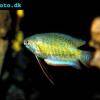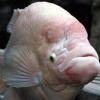Thick lip gourami - Trichogaster labiosus
Scientific name: Trichogaster labiosus
Common name: Thick lip gourami
Family: Osphronemidae
Usual size in fish tanks: 7 - 9 cm (2.76 - 3.54 inch)
014
Recommended pH range: 6 - 7.5
Recommended water hardness: 4 - 10°N (71.43 - 178.57ppm)
0°C 32°F30°C 86°F
Recommended temperature range: 22 - 28 °C (71.6 - 82.4°F)
The way how these fish reproduce: Spawning
Where the species comes from: South Asia
Temperament to its own species: peaceful
Temperament toward other fish species: peaceful
Usual place in the tank: Top levels
Feeding
The Thick Lip Gourami (Trichogaster labiosus) is an omnivorous species that thrives on a varied diet. While they will readily accept high-quality flakes and granules, their diet should be supplemented with live or frozen foods such as brine shrimp, bloodworms, and daphnia to support their health and vibrant coloration. Feed them small portions 2-3 times daily to ensure optimal digestion and prevent overfeeding. Additionally, incorporating a fasting day once a week allows their digestive system to rest and helps maintain water quality.
Origin
The Thick Lip Gourami originates from South and Southeast Asia, specifically in India, Bangladesh, and Myanmar. They inhabit slow-moving or stagnant waters like ponds, marshes, and rice paddies. These environments are warm, soft, and slightly acidic to neutral, often filled with dense vegetation that provides shelter and breeding areas.
Sexing
Sexing Trichogaster labiosus is relatively straightforward. Males are more vibrantly colored than females and may develop slightly elongated dorsal fins. During breeding, males often display enhanced coloration as part of their courtship behavior.
Breeding
Thick Lip Gouramis are bubble-nest builders, with males taking the lead in constructing and guarding the nest. Floating plants such as Pistia (Water Lettuce) or Frogbit are highly appreciated as they help stabilize the nest. To encourage breeding, maintain water temperatures around 26-28°C (78.8-82.4°F) and provide soft, slightly acidic water. After spawning, the male tends to the eggs and fry, which typically hatch within 24-36 hours. Once the fry become free-swimming, they can be fed infusoria or finely crushed flakes until they are large enough to accept larger foods.
Lifespan
With proper care, the Thick Lip Gourami can live up to 3-4 years in captivity. Stable water conditions, a balanced diet, and a stress-free environment are essential to ensure their longevity.
Tank Setup
To replicate their natural habitat, provide a well-planted aquarium with a minimum size of 75 liters (~20 gallons). Include floating plants like Amazon Frogbit or Salvinia to create shaded areas and mimic their native environment. Driftwood and caves can also serve as hiding spots, promoting their sense of security. Maintain water parameters within their ideal range: temperature 22-28°C (71.6-82.4°F), pH 6.0-7.5, and hardness 4-10°N (71.43-178.57ppm). Gentle filtration is crucial, with different types offering specific benefits:
- Sponge Filter: Ideal for low-flow tanks, provides excellent biological filtration and gentle water movement, suitable for gouramis that prefer calm waters.
- Internal Filter: Offers a balance of mechanical and biological filtration, compact and effective but may require more frequent maintenance.
- Canister Filter: Best for larger tanks, provides superior filtration and customizable media options but may create stronger currents unless adjusted.
Choose a filtration system that aligns with the tank size and the gouramis' preference for gentle water flow. Regular water changes are also essential to maintain high water quality.
Compatible Tankmates
The peaceful nature of Thick Lip Gouramis makes them excellent candidates for community tanks. Suitable tankmates include:
Avoid aggressive or overly boisterous species, as they may stress the gouramis. Providing plenty of visual barriers and hiding spots can help maintain a harmonious tank environment.
Short Description
The Thick Lip Gourami (Trichogaster labiosus) is a peaceful and hardy fish native to South and Southeast Asia. Known for their vibrant colors and bubble-nest-building behavior, they thrive in well-planted aquariums with soft, slightly acidic water. Their calm demeanor makes them ideal for community tanks, where they can coexist with other gentle species. With proper care, these gouramis make a captivating and rewarding addition to any aquarium.
Pictures
Bought by aqua-fish.net from jjphoto.dk.





 Akar
Akar  Whiteseam
Whiteseam  Giant
Giant  Betta
Betta  Slender
Slender  Betta
Betta  Brown’s
Brown’s  Snakehead
Snakehead  Wine
Wine  Edith’s
Edith’s  Blue
Blue  Betta
Betta  Peaceful
Peaceful  Kapaus
Kapaus  Eyespot
Eyespot  Spotted
Spotted  Forest
Forest  Schaller’s
Schaller’s  Siamese
Siamese  Chukai
Chukai  Banded
Banded  Dwarf
Dwarf  Frail
Frail  Paradise
Paradise  Giant
Giant  Giant
Giant  Licorice
Licorice  Chocolate
Chocolate  Honey
Honey  Pearl
Pearl  Moonlight
Moonlight  Snakeskin
Snakeskin  Blue
Blue